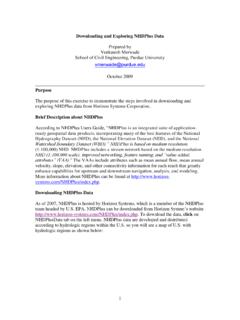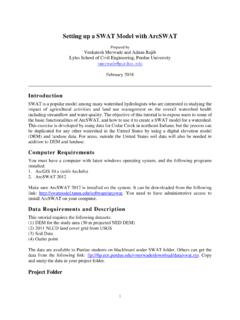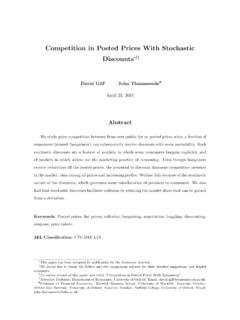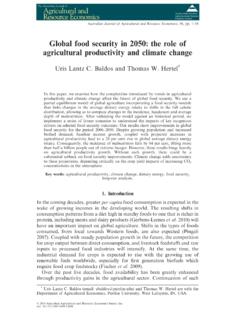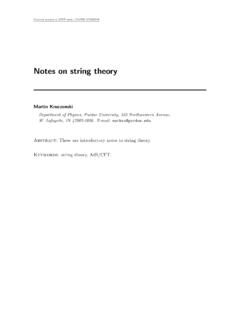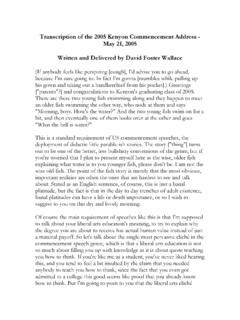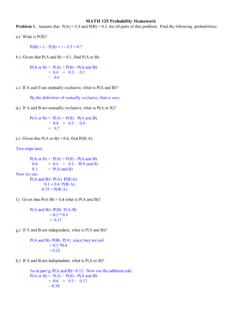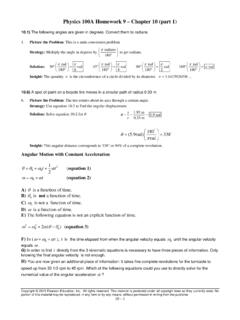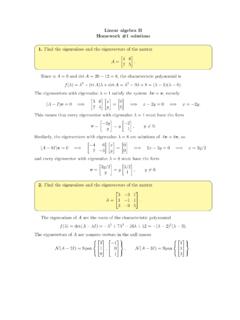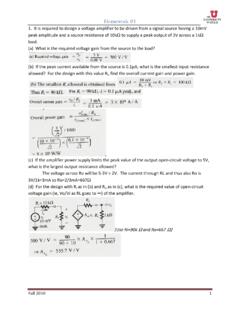Transcription of ECE 301: Signals and Systems Homework Solution #1
1 ECE 301: Signals and SystemsHomework Solution #1 Professor:Aly El GamalTA:Xianglun Mao1 Aly El GamalECE 301: Signals and Systems Homework Solution #1 Problem 1 Problem 1 Determine the values ofP andE for each of the following Signals :(a)x1(t) =e 2tu(t)(b)x2(t) =ej(2t+ /4)(c)x3(t) =cos(t)(d)x1[n] = (12)nu[n](e)x2[n] =ej( /2n+ /8)(f)x3[n] =cos( 4n) Solution (a)E = 0e 2tdt= = 0, becauseE < .(b)x2(t) =ej(2t+ /4),|x2(t)|= 1. Therefore,E = |x2(t)|2dt= dt= .P = limT 12T T T|x2(t)|2dt= limT 12T T Tdt= limT 1 = 1.(c)x3(t) =cos(t). Therefore,E = |x3(t)|2dt= cos2(t)dt= .P = limT 12T T T|x3(t)|2dt= limT 12T T Tcos2(t)dt= limT 12T T T(1 +cos(2t)2)dt=12.
2 (d)x1[n] = (12)nu[n],|x1[n]|2= (14)nu[n]. Therefore,E = n= |x1[n]|2= n=0(14)n= = 0, becauseE < .(e)x2[n] =ej( /2n+ /8),|x2[n]|2= 1. Therefore,E = n= |x2[n]|2= n= 1 = .P = limN 12N+ 1N n= N|x2[n]|2= limN 12N+ 1N n= N1 = 1.(f)x3[n] =cos( 4n). Therefore,E = n= |x3[n]|2= n= cos2( 4n) = .P = limN 12N+ 1N n= N|x3[n]|2= limN 12N+ 1N n= Ncos2( 4n) = limN 12N+ 1N n= N(1 +cos( 2n)2) = El GamalECE 301: Signals and Systems Homework Solution #1 Problem 2 Problem 2A continuous-time signalx(t) is shown in Figure 6. Sketch and label carefully each of the following Signals :(a)x(4 t2)(b) [x(t) +x( t)]u(t)(c)x(t)[ (t+32) (t 32))]Figure 1: The continuous-time signalx(t).
3 SolutionFigure 2: Sketches for the resulting El GamalECE 301: Signals and Systems Homework Solution #1 Problem 3 Problem 3A discrete-time signalx[n] is shown in Figure 3. Sketch and label carefully each of the following Signals :(a)x[3n](b)x[n]u[3 n](c)x[n 2] [n 2]Figure 3: The discrete-time signalx[n].SolutionFigure 4: Sketches for the resulting El GamalECE 301: Signals and Systems Homework Solution #1 Problem 4 Problem 4 Deternmine and sketch the even and odd parts of the Signals depicted in Figure 5. Label your 5: The continuous-time signalx(t).SolutionFigure 6: Sketches for the resulting El GamalECE 301: Signals and Systems Homework Solution #1 Problem 5 Problem 5 Letx(t) be the continuous-time complex exponential signalx(t) =ejw0twith fundamental frequency 0and fundamental periodT0= 2 / 0.
4 Consider the discrete-time signalobtained by taking equally spaced samples ofx(t) - that is,x[n] =x(nT) =ej 0nT(a) Show thatx[n] is periodic if and only ifT/T0is a rational number - that is, if and only if some multipleof the sampling interval exactly equals a multiple of the period ofx(t).(b) Suppose thatx[n] is periodic - that is, thatTT0=pq(1)wherepandqare integers. What are the fundamental period and fundamental frequency ofx[n]?Express the fundamental frequency as a fraction of 0T.(c) Again assuming thatTT0satisfies equation (1), determine precisely how many periods ofx(t) are neededto obtain the samples that form a single period ofx[n].
5 Solution (a) Ifx[n] is periodic, thenej 0(n+N)T=ej 0nT, where 0= 2 /T0. This implies that2 T0NT= 2 k TT0=kN= a rational a rational number, then we haveTT0=kN 2 T0NT= 2 implies thatej 0(n+N)T=ej 0nT, where 0= 2 [n] is the above two conditions, we can conclude thatx[n] is periodic if and only ifT/T0is arational number.(b) IfTT0=pqthenx[n] =ej2 n(pq).The fundamental period isN=q/gcd(p,q) (gcd refer to the greatestcommon divisor). The fundamental frequency is2 qgcd(p,q) =2 ppqgcd(p,q) = 0 Tpgcd(p,q)(c) We know that the fundamental period of (b) isN=q/gcd(p,q), so overallNTT0=p/gcd(p,q) periodsofx(t) is needed to obtain the samples that form a single period ofx[n].
6 6
